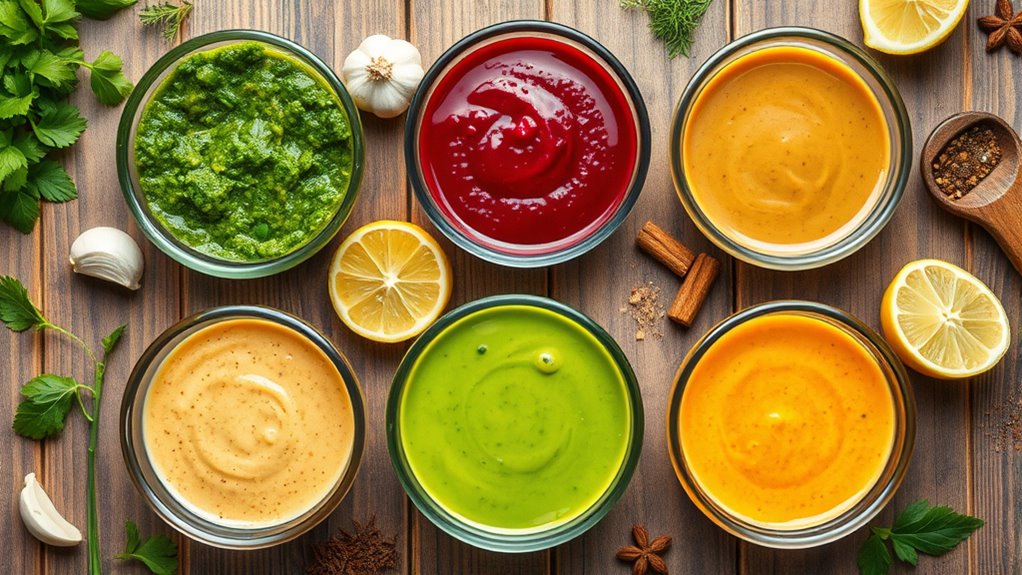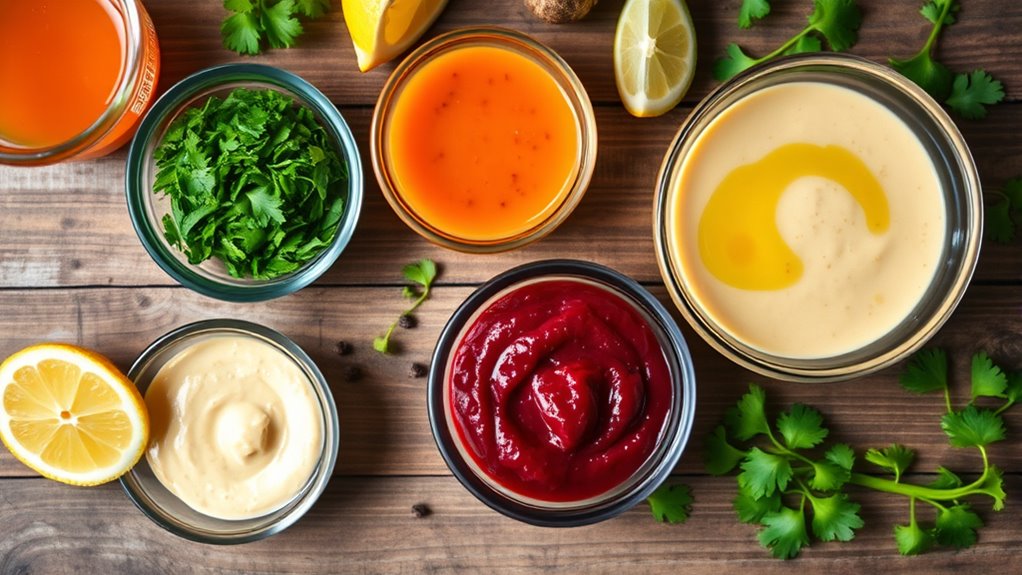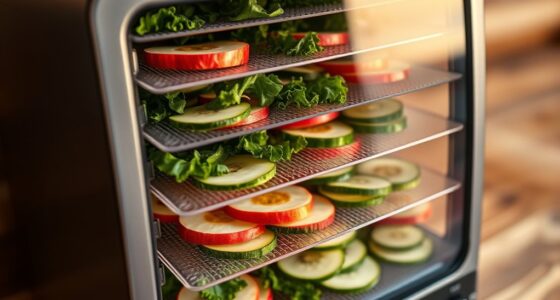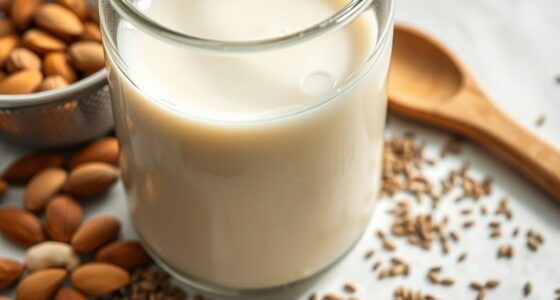Master formulas for raw dressings and sauces are versatile bases you can easily customize based on your ingredients and taste preferences. Using simple ratios like three parts oil to one part acid, you can create endless variations by swapping different oils, vinegars, or fresh herbs. Adjust flavors with sweeteners or spices, add textures with nuts or seeds, and balance acidity and richness for perfect results. Keep experimenting, and you’ll discover how flexible these formulas can be for your dishes.
Key Takeaways
- Use flexible ratios like 3:1 oil to acid as a base for creating customizable dressings.
- Incorporate aromatic ingredients, herbs, nuts, or seeds to add flavor and texture variations.
- Substitute ingredients (e.g., vinegars, oils, herbs) to tailor dressings for different tastes and dietary needs.
- Balance flavors by adjusting acidity, sweetness, salt, and fat to achieve harmony in each recipe.
- Experiment with seasonings and textures to craft endless dressing and sauce variations suited to any dish.

Creating flavorful raw dressings and sauces doesn’t have to be complicated; with master formulas, you can easily customize and elevate your dishes. These formulas serve as a foundation, allowing you to adapt ingredients based on what you have on hand or to suit your taste preferences. When working with them, ingredient substitutions are your best tools. For example, swap out lemon juice for lime or apple cider vinegar for balsamic to change the acidity profile. You can also replace fresh herbs with dried ones or experiment with different oils—like olive, avocado, or sesame—to influence texture and flavor. These substitutions help you keep your recipes versatile and prevent boredom.
Flavor balancing is essential when creating dressings and sauces. It’s about achieving harmony among acidity, sweetness, salt, and fat. If your dressing tastes too sharp or sour, add a touch of natural sweetener like honey or maple syrup to mellow the acidity. Conversely, if it’s too bland or flat, a pinch of sea salt or a splash of tamari can enhance its depth. Incorporating rich oils adds body and helps tie the flavors together, but be careful not to overdo it—balance is key. When adjusting the flavor, taste frequently to ensure each element complements the others, creating a well-rounded sauce.
Achieve harmony in dressings by balancing acidity, sweetness, salt, and fat through careful tasting and adjustments.
Master formulas make this process straightforward. For example, a basic vinaigrette can be built on a ratio of 3 parts oil to 1 part acid, with added seasonings. Once you understand this, you can tweak the ratios or ingredients for endless variations. If you want a spicy kick, add a dash of hot sauce or a pinch of red pepper flakes. For a more herbaceous profile, blend in fresh parsley, basil, or cilantro. These formulas also allow you to incorporate different textures—like adding chopped nuts or seeds for extra crunch—or to incorporate aromatics such as garlic or shallots, which can be minced or pureed for smoothness.
The beauty of master formulas is that they’re adaptable. You can create a creamy avocado dressing by blending ripe avocado with lemon juice, olive oil, and a touch of garlic, then adjust the seasoning as needed. Or, craft a tangy tahini sauce by whisking tahini with lemon juice, water, and a pinch of cumin, tweaking the acidity and thickness to suit your preference. With a bit of experimentation and an understanding of flavor balancing, you’ll find that customizing your raw dressings becomes a quick, enjoyable process. This approach empowers you to turn simple ingredients into complex, delicious sauces that enhance any dish. Additionally, understanding rustic decor principles can inspire presentation styles that elevate your dishes visually when serving homemade dressings at gatherings.
Frequently Asked Questions
Can I Substitute Ingredients for Allergies or Preferences?
Yes, you can definitely use ingredient substitutions for allergy-friendly options or personal preferences. When making raw dressings and sauces, choose alternative ingredients that match the flavors and textures you’re aiming for. For example, swap out nuts for seeds or use dairy-free options. Just make certain your substitutions maintain the balance of acidity, creaminess, and sweetness. Experimenting with ingredient substitutions allows you to create delicious, allergy-friendly dressings that suit everyone’s needs.
How Long Do Homemade Dressings Stay Fresh?
Think of homemade dressings like a delicate flower—best enjoyed fresh. Usually, they stay good for 3 to 7 days if stored properly in an airtight container in the fridge. To extend shelf life, use preservative methods like adding lemon juice or vinegar, which act as natural preservatives. Always check for signs of spoilage, like off smells or mold, before using, and when in doubt, toss it out.
Are Raw Dressings Safe to Store at Room Temperature?
Raw dressings aren’t safe to store at room temperature because of food safety concerns. Bacteria can grow quickly, especially with ingredients like fresh herbs, garlic, or dairy. To keep your dressings fresh and safe, always store them in the refrigerator and follow proper storage tips. Typically, homemade raw dressings last about 3-5 days in the fridge. If you notice any off smell or mold, discard them immediately.
What Are Some Budget-Friendly Ingredient Options?
Imagine you’re making a simple vinaigrette and want to keep costs low. You can use affordable pantry staples like vinegar, olive oil, and mustard as your base. To boost flavor without breaking the bank, add cost-effective flavor boosters like garlic powder or dried herbs. These ingredients are versatile, budget-friendly, and easily available, helping you create tasty dressings and sauces without overspending while maintaining great flavor.
How Can I Adjust Flavor Profiles for Specific Cuisines?
To adjust flavor profiles for specific cuisines, you need to understand their cultural flavor profiles and ingredient nuances. Use spice blend adjustments—add cumin and coriander for Middle Eastern, soy sauce and sesame for Asian, or herbs like basil and oregano for Italian. Taste as you go, balancing acidity, sweetness, and saltiness to match the authentic flavor. This approach helps you create dressings and sauces that truly reflect the cuisine’s essence.
Conclusion
Remember, variety is the spice of life—and with these master formulas, you’re all set to create endless raw dressings and sauces. Don’t be afraid to experiment and make each recipe your own. As the saying goes, “The proof of the pudding is in the eating.” So, plunge in, get creative, and enjoy the delicious journey of flavor-building. Your perfect dressing or sauce is just a few tweaks away!










